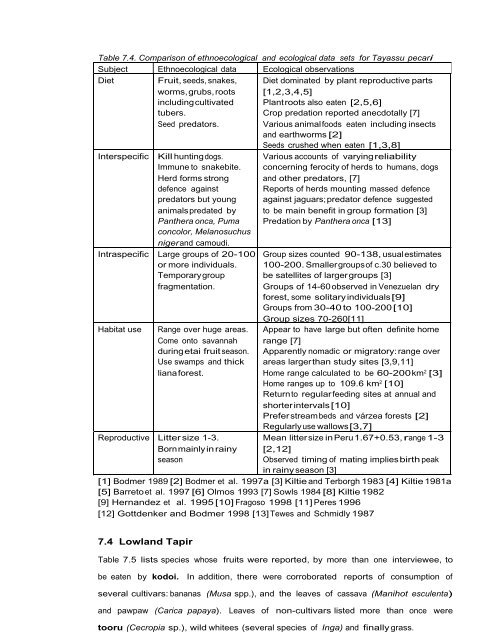Ethnoecology, Resource Use, Conservation And Development In A ...
Ethnoecology, Resource Use, Conservation And Development In A ...
Ethnoecology, Resource Use, Conservation And Development In A ...
Create successful ePaper yourself
Turn your PDF publications into a flip-book with our unique Google optimized e-Paper software.
Table 7.4. Comparison of ethnoecological and ecological data sets for Tayassu pecari<br />
Subject Ethnoecological data Ecological observations<br />
Diet Fruit, seeds, snakes, Diet dominated by plant reproductive parts<br />
worms, grubs, roots [1,2,3,4,5]<br />
including cultivated Plant roots also eaten [2,5,6]<br />
tubers.<br />
Crop predation reported anecdotally [7]<br />
Seed predators. Various animal foods eaten including insects<br />
and earthworms [2]<br />
Seeds crushed when eaten [1,3,8]<br />
<strong>In</strong>terspecific Kill hunting dogs. Various accounts of varying reliability<br />
Immune to snakebite. concerning ferocity of herds to humans, dogs<br />
Herd forms strong and other predators, [7]<br />
defence against<br />
Reports of herds mounting massed defence<br />
predators but young against jaguars; predator defence suggested<br />
animals predated by to be main benefit in group formation [3]<br />
Panthera onca, Puma<br />
concolor, Melanosuchus<br />
niger and camoudi.<br />
Predation by Panthera onca [13]<br />
<strong>In</strong>traspecific Large groups of 20-100 Group sizes counted 90-138, usual estimates<br />
or more individuals. 100-200. Smaller groups of c.30 believed to<br />
Temporary group be satellites of larger groups [3]<br />
fragmentation.<br />
Groups of 14-60 observed in Venezuelan dry<br />
forest, some solitary individuals [9]<br />
Groups from 30-40 to 100-200 [10]<br />
Group sizes 70-260[11]<br />
Habitat use Range over huge areas. Appear to have large but often definite home<br />
Come onto savannah range [7]<br />
during etai fruit season. Apparently nomadic or migratory: range over<br />
<strong>Use</strong> swamps and thick areas larger than study sites [3,9,11]<br />
liana forest.<br />
Home range calculated to be 60-200 km2 [3]<br />
Home ranges up to 109.6 km2 [10]<br />
Return to regular feeding sites at annual and<br />
shorter intervals [10]<br />
Prefer stream beds and várzea forests [2]<br />
Regularly use wallows [3,7]<br />
Reproductive Litter size 1-3. Mean litter size in Peru 1.67+0.53, range 1-3<br />
Born mainly in rainy [2,12]<br />
season<br />
Observed timing of mating implies birth peak<br />
in rainy season [3]<br />
[1] Bodmer 1989 [2] Bodmer et al. 1997a [3] Kiltie and Terborgh 1983 [4] Kiltie 1981a<br />
[5] Barreto et al. 1997 [6] Olmos 1993 [7] Sowls 1984 [8] Kiltie 1982<br />
[9] Hernandez et al. 1995 [10] Fragoso 1998 [11] Peres 1996<br />
[12] Gottdenker and Bodmer 1998 [13] Tewes and Schmidly 1987<br />
7.4 Lowland Tapir<br />
Table 7.5 lists species whose fruits were reported, by more than one interviewee, to<br />
be eaten by kodoi. <strong>In</strong> addition, there were corroborated reports of consumption of<br />
several cultivars: bananas (Musa spp.), and the leaves of cassava (Manihot esculenta)<br />
and pawpaw (Carica papaya). Leaves of non-cultivars listed more than once were<br />
tooru (Cecropia sp.), wild whitees (several species of <strong>In</strong>ga) and finally grass.


